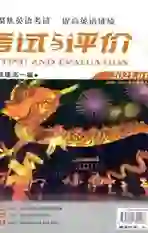V-ing形式作宾语补足语和状语
2021-08-14程亚芳
程亚芳
一、V-ing形式作宾语补足语
【知识清单】
1. 在see, hear, feel, watch, notice, hear等感官动词后和catch, find, have, keep, leave等动词之后可以用V-ing 形式作宾语补足语。这时V-ing形式和句子宾语之间存在逻辑上的主谓关系,并且V-ing形式表示正在进行的动作。如:
I could feel the wind blowing on my face. 我能感到风迎面吹来。
When the teacher caught the boy student cheating in the exam, he made him go out. 发现这个男学生正在作弊,老师让他出去了。
The two cheats had the lights burning all the night. 两个骗子让灯亮了一个晚上。
2. 以上结构中有很多可变为被动形式。如:
He was found / spotted / caught lying on the ground. 有人发现他躺在地上。
The papers were left lying around. 文件散落一地。
3. 动词不定式和V-ing形式作宾语补足语的区别。
在see, hear, feel, watch, notice等感官动词后,既可用V-ing形式作宾语补足语,也可用不带to的不定式作宾语补足语,两者之间有一定的区别。用V-ing形式时,表示动作正在进行;用动词不定式时,表示动作的全过程。如:
Do you hear someone knocking at the door? 你听见有人正在敲门吗?(表动作)
Do you hear someone knock at the door? 你听见有人敲门了吗?(表全过程)
注意:表全过程时变被动时加to。(see sb. do—sb. be seen to do)
二、V-ing形式作状语
【知识清单】
V-ing形式可以在句子中作状语来修饰谓语动词或整个句子,表示动作发生的时间、原因、条件、结果、让步、方式或伴随状况。其基本句型:V-ing短语+主语+谓语+句子的其他成分。如:
Having worked for four hours, she stopped to have her meal. (时间)她干了四个小时后停下来吃饭。
Exercising every morning, you will improve your health. (条件)如果每天做早操,你的健康会好转。
Granting the achievements to be great, there is still something to be desired. (让步)尽管成绩是巨大的,但仍然有一些要求改进的东西。
They began to build their dreams, eventually making them a reality. (结果)他们开始构建梦想,最终将梦想变成现实。
We spend most of our waking hours communicating. (方式)我们清醒时的大部分时间都在交流。
Having no interest in the topic, he didnt go to the lecture. (原因)由于對这个话题没兴趣,他没去参加讲座。
We were sitting by the window, talking about what happened yesterday. (伴随)我们坐在窗户边,谈论着昨天发生的事。
【温馨提示】
1. V-ing形式作状语时,它的逻辑主语是句子的主语。如果主语不一致,保留各自的主语。
2. 一般来说,如果V-ing形式表示的动作和谓语动词表示的动作同时发生或近乎同时发生,则V-ing短语放在句首。
3. 如果V-ing形式所表示的动作发生在谓语动词所表示的动作之后,则V-ing短语放在句子的结尾。
4. 当分词表示的动作发生在主句的动作之前时,用V-ing形式的完成式(having done)作状语,放在句首,译作“在……之后”,此时它可以替换为“after+动名词”这一结构。如:
Having turned off the TV set, he began to go over his lessons. 关掉电视机以后,他便开始复习功课。
=After turning off the TV set, he began to go over his lessons.
【记忆口诀】
1. 分词作状语,主语是问题。逗号前后两动作,共用一主语。
2. 主语找出后,先看词性(及物动词无宾语用done,有宾语用doing;系动词和不及物动词用doing),再来判关系。主动用V-ing, 被动用V-ed。
3. having done 表先后,千万要牢记。
【实战演练】
一、单句语法填空。
1. ____ (find) the course very difficult, she decided to move to a lower level.
2. Our car was caught in a traffic jam, thus ____(cause) the delay.
3. We wont have you ____ (get) away with telling people lies.
4. Lucys new job paid twice as much as she had made ____ (work) in the restaurant.
5. ____ (wait) in the queue for half an hour, the old man suddenly realized he had left the cheque in the car.
6. The lady walked around the shops, ____ (keep) an eye out for bargains.
7. We heard them ____ (quarrel) about money after the concert; they looked very angry.
8. I noticed my little son ____ (read) the words ____ (write) on his small blackboard.
9. ____ (look) at my classmates faces, I read the same excitement in their eyes.
10. ____ (fail) to reach them on the phone, we sent an e-mail instead.
11. They knew her very well. They had seen her ____ (grow) up from childhood.
12. Paul doesnt have to be made ____ (learn). He always works hard.
13. I smell something ____ (burn) in the kitchen. Can I call you back in a minute?
14. We explored the cave, Black ____ (act) as a guide.
15. At the press conference Yao Ming announced a personal decision, ____ (end) his career as a basketball player.
二、用V-ing形式完成下面的短文,使文章更生動。
1. ________ (站起来四周走动), the young mother held her 2. ________(微笑的) baby. He was very quiet and peaceful, 3. ________ (好奇地看着他的周围). After a while, his mother, 4. ________ (因为累了), sat down. The baby immediately started to cry. 5. ________ (在她的手臂中跳上跳下), he screamed at the top of his lungs. The 6. ________ (皱眉的) mother quickly pulled a bottle out of her bag and gave it to her baby. 7. _________ (紧紧地抓着瓶子), the baby was again quiet and peaceful. 8. _________ (看着孩子欢快地喝着), she smiled in relief.
